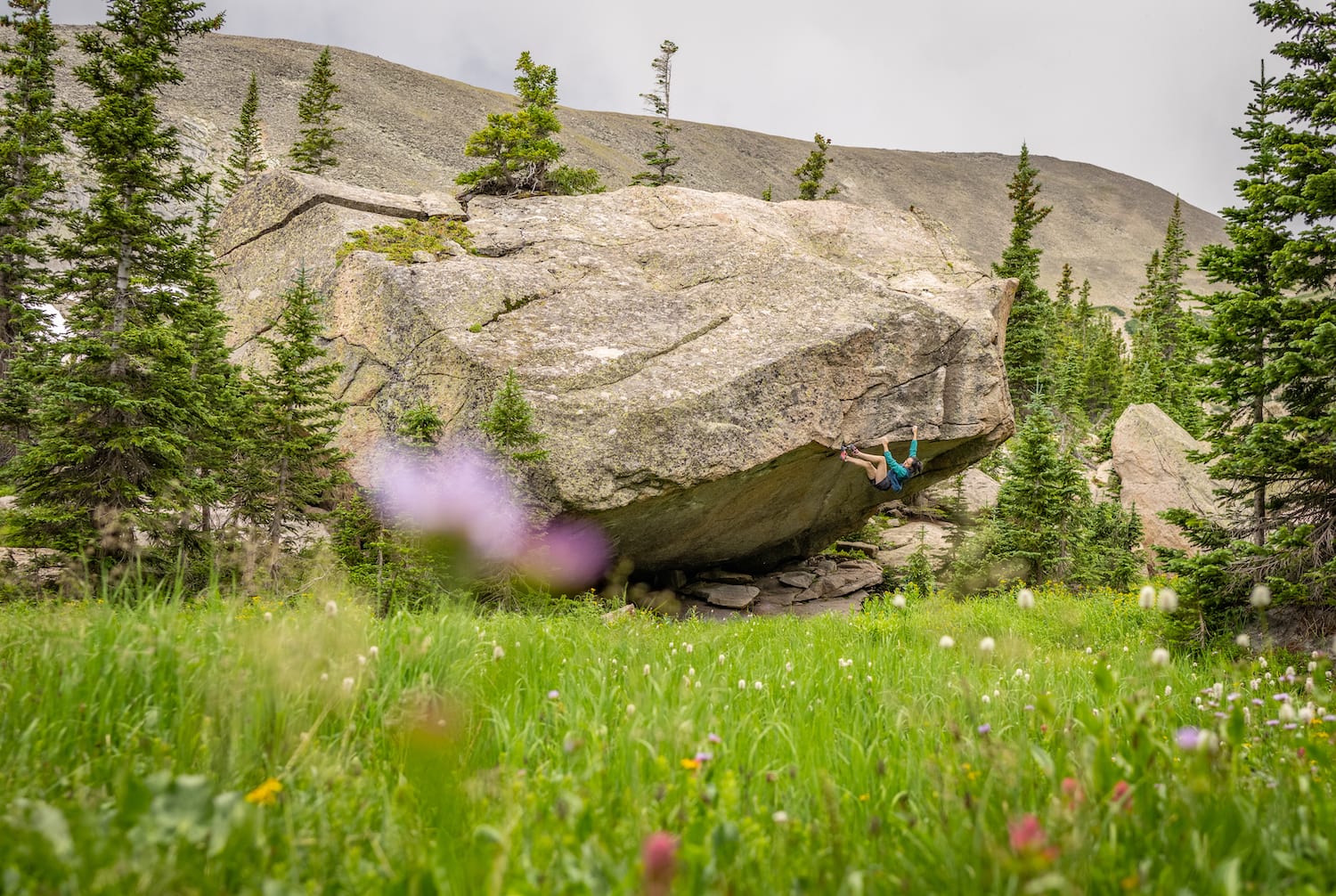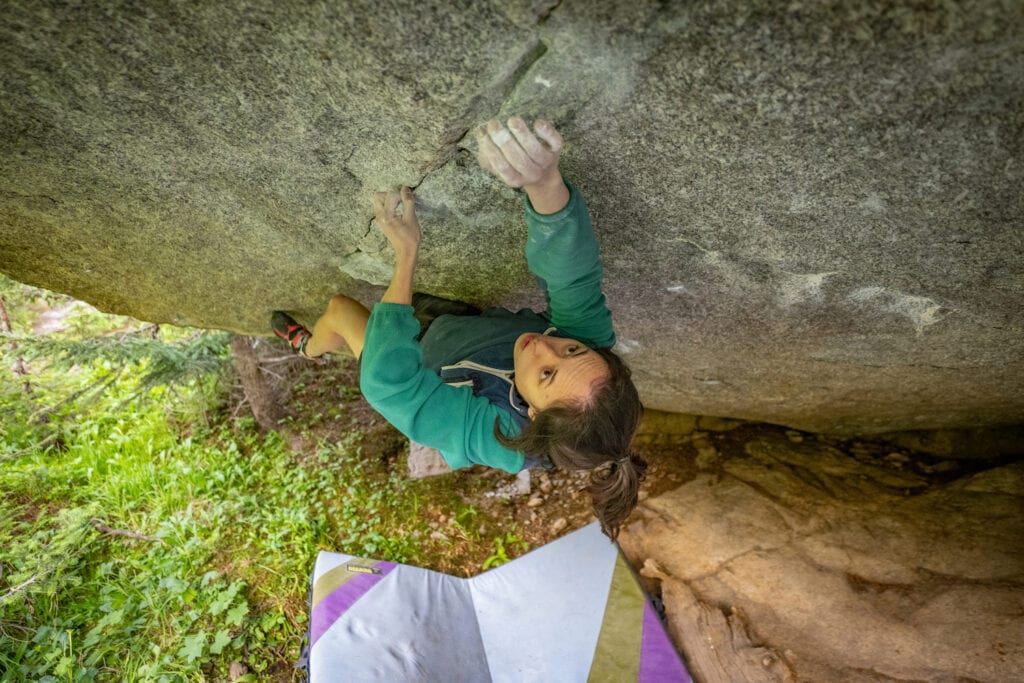Katie Lamb Exclusive Interview: First Woman to Send V16 with “Box Therapy”

The 25-year-old American made history this summer, becoming the first female boulderer to tackle the V16 grade.
Last week, American climber Katie Lamb, 25, announced a surprising late-summer achievement. On July 28th, she’d topped the pristine alpine boulder Box Therapy (V16) in Rocky Mountain National Park. In doing so, Lamb has jumped over the V15 grade entirely, and become the first woman in history to solve a V16 (8C+) boulder problem.
Box Therapy, put up by Daniel Woods in 2018, has seen only two other repeats, from Drew Ruana and Sean Bailey. It’s not just a hard boulder to climb though. It’s a hard boulder to get to, sitting at an elevation of 10,500 feet (3,200 meters) over six miles from the nearest trailhead. Lamb told Climbing House she hiked out and back to the problem for seven sessions. In total, she estimates she clocked over 90 miles while working the problem.
But what does this achievement mean for Lamb? What did the process look like? Why did she wait a month to tell everyone? Read on for an exclusive interview with the first woman to send V16.
Editor’s note: Brooke Raboutou repeated Box Therapy in October 2023 and “felt like V15 is an appropriate grade.” Will V16 stand? We’ll need a few more repeats to find out.
So Katie, I feel this is one of those sends that can get shanghaied by flashy titles like ‘First Woman to Send V16.’ That’s unavoidable, and it’s honestly probably what the title of this interview will be. But I bet this can also put you in a box (no pun intended). So I’d like to start by asking, what—to you—is meaningful about this achievement?
Yeah, for me it can feel that way any time I do a boulder of the next level or I do my hardest, proudest accomplishment. I actually did [Box Therapy] in July. So, for the month of August, it definitely felt like that.
But since telling the world, it’s taken on a different tone. I’m really glad that people feel inspired by it and are genuinely happy and supportive. That’s been awesome. That’s always the best part about sharing climbing accomplishments for me… connecting and meeting new people and feeling like you can contribute something.
Climbing V16 or being the first woman to climb V16 was not the reason that I started trying [Box Therapy], but it’s a happy side effect. Just being able to contribute to the climbing world and community in some way [via this send] feels like the best part.
So what about Box Therapy was so intriguing? Why’d you go after it?
It had been on my radar since Daniel did the FA, but now the timing was right. I was going to spend the summer in Colorado and I’d done a lot of the stuff that I want to do there already.
[Box Therapy] is also extremely beautiful. It’s stunning when you get there. It’s in this super lush meadow, a giant boulder with a really obvious line of crimps. It’s really rare for hard boulders to have good rock and also tiny crimps. It’s a great style for me. It’s a combination of the amazing quality of the line, the beautiful setting, and the timing was right. I felt ready.
Did the long approach give you a mental edge? The space to work through stuff in your head? Or was it just more like, ‘This is a pain in the *ss’?
I think in order to do [the boulder], there’s an aspect of needing to fully disassociate from the hike or be grateful for it. If you can’t come to terms with the hike, it’s really hard to do the boulder.
So I don’t know if I was tricking myself and using it as a defense mechanism, but I started liking the time as a way to talk to friends, or if I was alone, a way to just be alone. When it was feeling heinous, I would put headphones in and listen to podcasts. There were some coping mechanisms. But ultimately, maybe it was helpful because I found a pretty good headspace [once I got to the boulder].
I imagine once you get all the way out there, you’re like, ‘Well, I better put it all in, I hiked out here six miles… It’s go time.’
Yeah, but I think for some people it can add an element of pressure. Like, ‘Oh, I walked all the way out there and I’m having a bad session.’ But in other ways, it forces you to stay and to keep learning and manage frustration. So it definitely adds a different mental game than a roadside boulder. But for me, I coped best by being grateful that I got to spend huge days outside and walk up to this magical little meadow and see a part of the mountains that not many people do.

Let’s talk nuts and bolts. What’s the problem like? How would you describe it from start to finish? And what was the crux for you?
It’s a seam basically up a 50-degree overhang. And it’s one seam with a line of crimps and it tops out this ship’s prow. It’s a lot steeper in person than I think it looks in photos. There was no crux move for me, really. The whole thing is pretty consistent, which is rare, but I would say the redpoint crux is the stand. I was able to link through the bottom fairly quickly, [but] there are some intricacies to the stand that make it hard from the ground.
When you were out there working it, were you with friends or alone? When you sent, were you alone?
When I sent I was alone, and I probably did two or three sessions alone. A couple of times I actually got to the boulder and there were people there, which was cool. It was nice to meet people. It’s always a little bit wild when you hike six miles and then find humans, and I definitely never mind when there are more people there. I also tried it with a handful of different friends, a rotating group of people that were trying that summer, which is really cool.
You wrote on your Instagram, “the pieces fit together on Box and it was about silencing my doubts and flipping the switch.” Can you elaborate? What were the doubts?
Often, when I’m trying projects in the initial sessions, there’s one move that feels really stopper or a move that I can do twice in a session but don’t feel I can link from the ground. In some ways, it’s easier to focus on that move and really break down that single move and try to figure out how I can make it so that I can do it every time.
With Box, there wasn’t one stopper move. Every move felt consistently hard. I think it’s just a different headspace where immediately the door is open, and there’s not the same problem-solving mentality. It becomes harder to manage expectations because you know that it’s feasible from the first session.
So [I had to] keep things in perspective and not think, ‘Oh, this is a boulder that I’ve always wanted to do. It’ll be the hardest boulder I’ve ever done. It’s also six miles in, and every time I go, I’m having these exhausting days.’ Instead of doing that, I had to just treat it like another day out climbing. That was essential.

Another thing you said on Instagram that I thought was interesting is: “Recently I’ve been feeling less excitement but more joy.” Can you elaborate? Are those emotions mutually exclusive?
I don’t know if they’re necessarily mutually exclusive. But when I was in high school or college, I would go on climbing trips and it would be the best week of the year. It was about being independent and living with friends for a week, surviving while camping, and all those aspects of climbing trips that are just so unique and enjoyable and totally independent of the climbing itself.
Back then doing anything [hard] or pushing my level at all was like, ‘Whoa… F*ck yeah! I had no idea that I could do that.’ It felt like it had this excitement level that was hard to find in any other aspect of life. That’s part of why I think bouldering and climbing is so addicting.
But recently, because my life is a bit of a perpetual climbing trip and my friends are geographically scattered and work jobs, I’m often not climbing with friends. I’m either climbing alone or with my two or three main climbing partners that I climb with all the time.
It’s not like we’re not having fun. We’re having a lot of fun. But now, it’s the day-to-day of climbing that brings me a lot of joy and purpose, even though there’s a higher percentage of frustrating or ‘not fun’ days than there used to be. Now it’s about feeling that long-term progression and motivation, instead of the endorphin hits from simply doing boulders.
Last question. You sent Box Therapy in late July. Why did you wait to tell people until now?
Part of it was logistics, trying to figure out what to do with the video, but that was only a small part. It’s not that I didn’t want to tell people. I always knew that I would tell people, but keeping it to myself and figuring out what it meant to me was important.
It definitely wasn’t a secret. If people asked me how my summer was, I would tell them. But [I wanted to] resist in my last moments of being anonymous and make sure I felt like I did it for myself and I knew what it meant to me, entirely separate from what the masses might think of it. I feel like that’s actually how I treat a lot of the stuff I do. I often don’t tell the world for a little bit, because it feels better at first when it feels like I’ve done something for myself.
You wanted to make sure you did it for yourself, but you were making sure of that after you’d already done it, right? Was there ever a doubt in your mind that you hadn’t actually done it for yourself?
I guess that was maybe the wrong way to put it. I always knew that I was doing it for myself. But I wanted to see how I personally felt about it and how it felt to do the hardest thing that I’ve ever done.
I also wanted to give myself a moment of rest. I feel like I didn’t climb very much in August. One thing I’ve been trying to do is enjoy making progress and enjoy completing boulders that are really [high quality] without looking at what’s next. I just wanted to celebrate it with my internal group of friends and feel like I finished something monumental in my own progression, and not necessarily monumental for the greater climbing world just yet.
